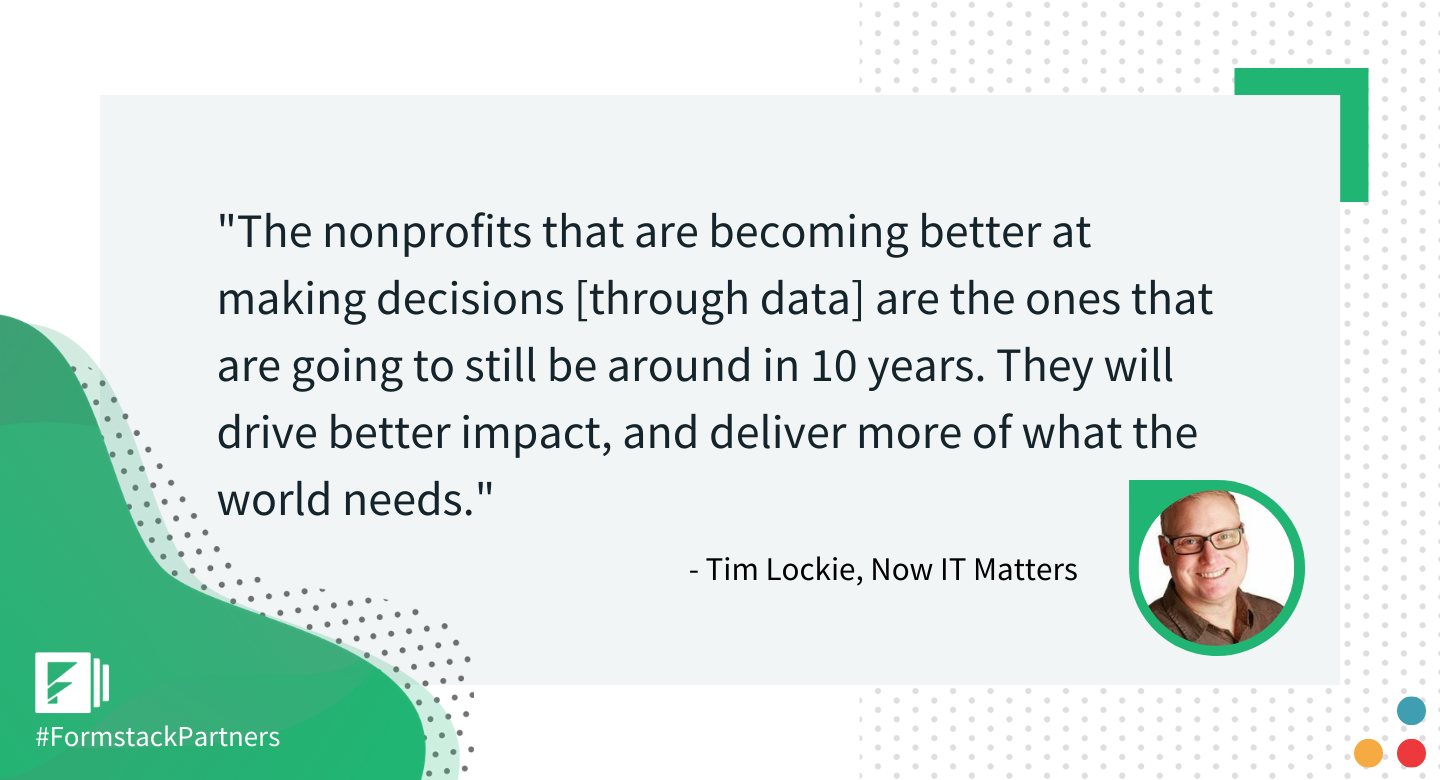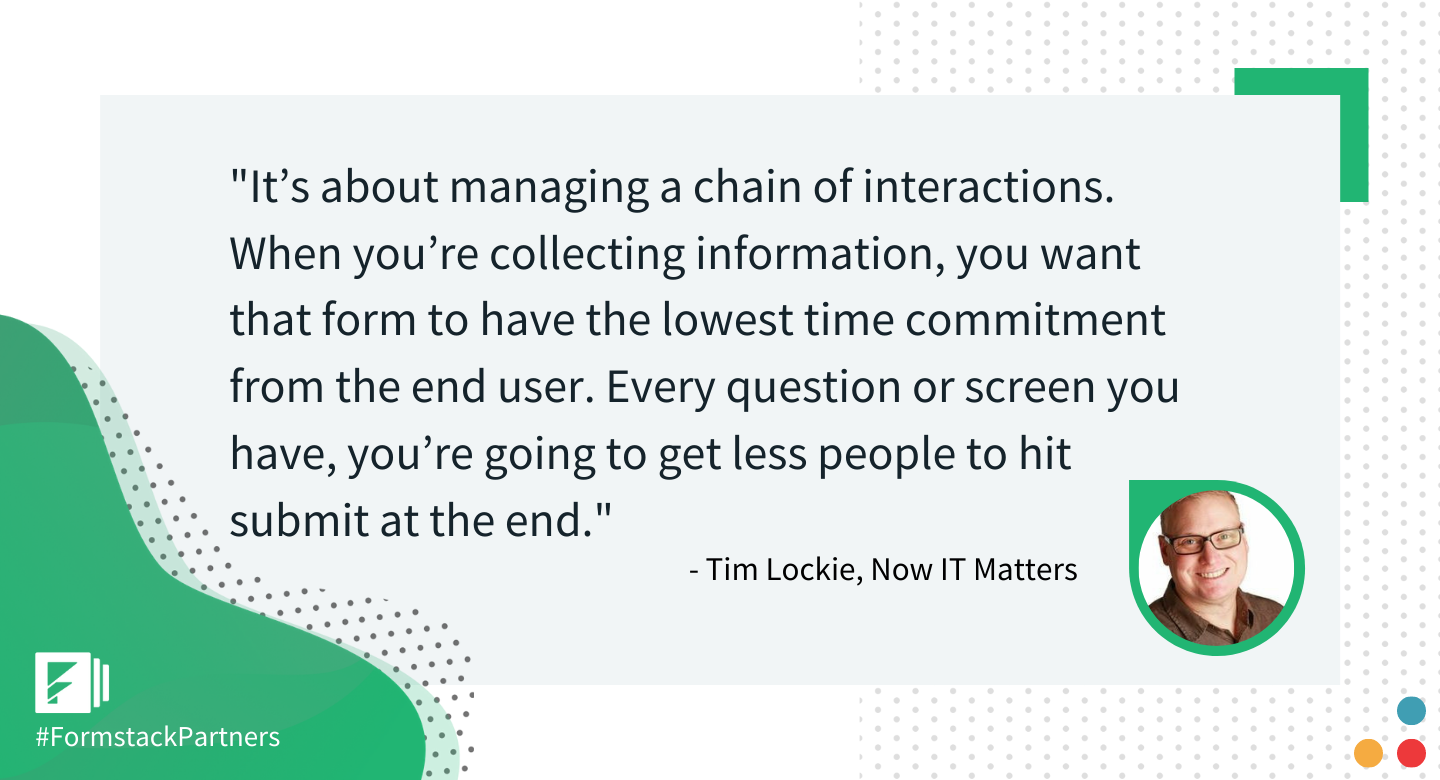Our VP of Partnerships Zak Pines recently sat down with Tim Lockie, President of Now IT Matters, as part of our ongoing Partner Interview Series. Zak and Tim had a far-ranging conversation that touched on how a top-performing nonprofit thinks about data, the Salesforce nonprofit community, and building processes to support chains of interactions with constituents. Here’s an abridged transcript of the chat.
Background on Now IT Matters (and How to Not Be in the 95%)
Zak: Can you start by telling us about Now IT Matters and how you position your business?
Tim: Now IT Matters helps nonprofits with digital impact use information to make better decisions about their work in strategic areas such as fundraising.
We like to think of it as making small impacts that have a big outcome. For an analogy, let’s say you are on a train from Texas headed to Alabama, but then you need to head to New York instead. If you are on the right spot on the tracks, you can pull a switch that causes a tiny piece of metal to move just a little bit, and that has a dramatic impact on your destination.
We help nonprofits make some of those adjustments that have a huge impact. For example, let's say you are an executive director walking into a crucial fundraising lunch, but you do not have information about the donor that you need at your fingertips. Of course, you would be more successful if you did have the information readily available. Minutes before the meeting, you could learn about the last gift the donor made or important info about their family; it puts you in a completely different place for that meeting to go well. The difference between those two lunches could be an ask of $10,000 versus $100,000.
Zak: That’s fascinating, and my burning question now is how exactly do you do that?
Tim: In the nonprofit space, there is plenty of data. The issue is that it’s not typically organized and available in a way to help executive leadership make decisions. We see that 95% of nonprofits that collect data don’t use that information when making key decisions.
The nonprofits that are becoming better at making decisions are the ones that are going to still be around in 10 years. They will drive better impact, and deliver more of what the world needs.

Zak: So in your experience, what is that 5% doing to use their data that the 95% is not?
Tim: You need to have information available to you so that it’s not just the data. You need a platform to convert data to information. And you need to have a vision for how that data will be used to help you make decisions.
When we work with a nonprofit, we start by asking how decisions are being made and what information could help to make more informed decisions. We want the information and decision-making to be the top priority of the initiative, not an afterthought.
Systems, by their nature, are “takers.” What I mean by that is they collect in information. We want our customers to think about how their systems can also be “givers”—how that information collected can be put to use for better decisions.
Zak: I feel like we are peeling back an onion here. How do you get to that point of being able to leverage your data to make better decisions for your nonprofit?
Tim: The key is making sure you start with the goals for that nonprofit. Begin with the end in mind.
We want to know, what are the key objectives for their executive director? Are they trying to increase the number of mentors by a certain percentage each year? Are they trying to deliver a certain number of services to a specific constituency? Do they have a certain conservation goal? And then we work backward from those goals. A nonprofit may be asking for help with something very specific, but then we help them to identify where they need to end up, and we build their CRM, data, and dashboards toward that end goal.
The Salesforce Nonprofit Community
Zak: How does Salesforce as a platform intersect with your business?
Tim: For nonprofits, there are a few systems out there—Blackbaud, Salesforce, and Microsoft are the big three. In the industry, there is a trend to move away from Blackbaud to Salesforce—and now increasingly to Microsoft as well.
We started in Salesforce. We have four MVPs on it. There is a huge, authentic community. Salesforce’s discounts to nonprofits are also huge in making it all possible. There’s a Nonprofit Success Pack and Education Data Architecture all written and sourced by the community.
Zak: Interesting. Can you tell me more about the Nonprofit Success Pack?
Tim: It started with higher education and now also covers K-12. Each of them are AppExchange add-ons that add common infrastructure and configuration changes to Salesforce, which dramatically change time to delivery when setting up a new Salesforce environment. It allows a customer to be running effectively in Salesforce—say, for capturing donations—in a couple of weeks.
Zak: What’s an example of the sorts of configurations that are automated?
Tim: It will, for example, group contacts together in a household, which is different than the traditional B2C space. The way you engage a household is different from how you might engage an individual or a company.
Another example is the concept of donation history roll-ups. You can see for a household which year they donated the most and their largest donation ever. There is easy access to those types of answers.
The Nonprofit Success Pack has been going since 2005. Now they are pushing releases every two weeks as a community.
Tim’s Day-to-Day as President of Now IT Matters & His Background
Zak: What does your typical day look like running your business?
Tim: I start every day with a daily standup with my executive team. We talk for 15 minutes about high-level issues that we need to know about or any fires that we need to put out.
We’re a 100% remote team, so we are running those as Zoom meetings.
After the daily standups, I connect with the staff for the first hour of our day. Then we move into client work, and I sometimes have meetings related to bringing on new clients.
In the afternoon, I reserve my time for thinking. I often think about what we need to do to build out our client mix. Sometimes I am hopping on the phone with a customer to get their opinion or planning out our next leadership initiative.
I may also use that time to work with our CFO—whom I’m married to—to talk about bills or invoices.
Zak: The work you are doing is fascinating. What is your background prior to Now IT Matters?
Tim: In January (2020), it will be ten years. We started in January 2010.
I’m a serial do-gooder. I’ve been working for nonprofits since I was 18, and I recruited and started a team that lived in places of poverty around the world. I also worked in one of the only urban centers in Montana with at-risk populations. So it’s all prepared me for this. The tech part, though, was a surprise.
Zak: When did the tech piece—CRM systems—come into it?
Tim: I always used systems differently than other people. Whenever an issue came up with a computer, I could fix it...usually out of not giving up.
When I found Salesforce, something clicked for me. There was something about a system that was both affordable and enterprise-grade. In my first implementation, we rolled out Salesforce to 50 users globally. I didn't have any training. No Trailhead. Just Google and perseverance.
I saw it had the power to transform organizations.
Salesforce Data Collection for Nonprofits
Zak: When along your Salesforce journey did you start working with Formstack?
Tim: I remember years ago getting a call from your team. I was headed out the door walking to an appointment of some kind. They wanted to know if I’d be interested in being part of a pilot for a new form tool. I said, “Probably not, but tell me about it.” It was a ten-minute walk. By the time I got to my destination, I said “Count me in.”
Zak: What are the types of use cases where you use Formstack for Salesforce?
Tim: It’s about managing a chain of interactions. When you’re collecting information, you want that form to have the lowest time commitment from the end user. Every question or screen you have, you’re going to get less people to hit submit at the end.

Dynamic prefill means that you are pre-populating data from Salesforce, allowing your users to review and use that data, and then you only need to add in new information.
Zak: Can you think of a specific example?
Tim: We have a client that does a lot with mentors. Those mentors are meeting with minors around town. As you can imagine, there is a fair amount of background to vet these mentors. So the client has the initial “raise your hand”/”I’m interested in doing this” form. Then there’s a second form: “Ok that’s great. Let’s have a conversation.”
Then there’s an interview, and information is collected, and some of that information is used for background checks. If the background check goes well, then there is a step to match volunteers to students.
Formstack lets us manage each step in that process, collecting the right information when we need it, and carrying information forward into Salesforce and the resulting processes.
These are continuous, evolving relationships with data at their core.
Zak: Not to talk bits and bytes, but it sounds like from a functionality standpoint, the ability to prefill data from Salesforce objects as part of continuous data collection is key?
Tim: That’s right. Oftentimes, there may be applications that need to be filled out year after year. So when you do that annual process, it’s powerful to start with your information from the previous year. Some information is static, some changes year over year. You want to allow your members to use previous information and just update as needed. You get more responses, and you get more respondents in your program, and that’s a significant payoff.
Lightning Round
Zak: Tim, you’ve been very generous with your time. Let’s wrap up with a quick lightning round. What are some of your hobbies?
Tim: I play Jumbie and other drums. I travel a lot. Diversity and inclusion are passions of mine.
Zak: What’s your favorite productivity tip?
Tim: Find a way to structure your projects so you can do your best work. For example, if you do your best work at the last minute, then plan accordingly.
Zak: What’s your favorite TV show?
Tim: I spend way too much time watching TV because I hate sleeping. I love “Game of Thrones.” “Firefly” was one of the best things ever. I’m making my way through “The Blacklist.”
Zak: What is your go-to lunch during the workday?
Tim: I hardly eat during the day. I’ll often skip breakfast. I will just have small bits of food throughout the day to munch on.
Zak: And our wrap-up question (we get all of our team members and partners to weigh in on it): Is a hot dog a sandwich?
Tim: No. That’s crazy. Shoot anybody that says it is.
Looking for your next step? Check out Formstack’s partner program for consultants, agencies, and tech partners.












